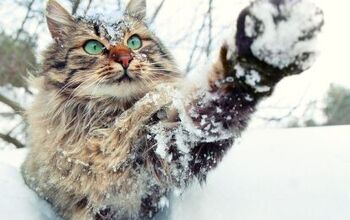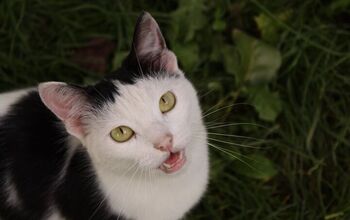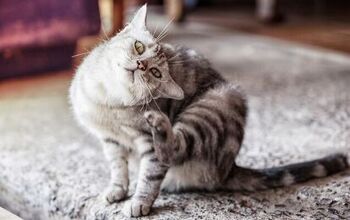Can Cats Get Dementia?

It starts as a slight, subtle shift. Maybe your senior cat, the one who has always greeted you at the door, now seems confused when you walk in. Or perhaps they’ve started meowing loudly in the middle of the night, a behavior completely out of character. For many cat parents, these changes are simply attributed to old age, a natural slowing down.
But what if it’s more than that? What if these aren’t just the harmless quirk of an aging cat, but instead, the first signs of a serious condition that requires your attention and care?
These changes are often symptoms of Feline Cognitive Dysfunction Syndrome (FCDS), a condition similar to Alzheimer's disease in humans. It’s a disorder that impacts a cat’s memory, awareness, and their learned behaviors. The good news is that, with the right information and a compassionate approach, you can still give your cat an incredible quality of life throughout their golden years.
What is Feline Dementia?
Feline Cognitive Dysfunction Syndrome (FCDS), otherwise known as Feline Dementia, is a progressive age-related decline in a cat’s cognitive function. On a biological level, for those interested, it involves a gradual breakdown of neurons and a buildup of proteins, like beta-amyloid, in the brain.
FCDS affects your cat’s ability to think, remember, and learn, having a lasting impact on many aspects of their life. The behavioral changes you see aren’t a choice that they are making; they’re a direct result of these physical changes in the brain. The condition is surprisingly common, with experts saying approximately one-third of cats aged 11-14 years old will show at least one sign of FCDS, increasing to 50% for cats over 15 years old.
While it’s easy to jump to conclusions when you see these changes, many symptoms associated with FCDS can be caused by other, very treatable, medical conditions that are also common in senior cats. This is why a vet visit is so necessary. A diagnosis of FCDS is often a diagnosis of exclusion, meaning they will first rule out other potential causes for the symptoms.
Some of the conditions with symptoms that are often mistaken for feline dementia include:
- Hyperthyroidism: This condition causes an overproduction of thyroid hormones, which can lead to hyperactivity, excessive vocalization, and restlessness that may look like FCDS symptoms.
- Hypertension (High Blood Pressure): Uncontrolled high blood pressure can cause your cat to become disoriented and confused, and may even lead to sudden blindness. These changes can all cause your cat to bump into things as if they are lost.
- Chronic Kidney Disease: This often results in increased thirst and urination, which can lead to accidents outside the litter box, which a cat parent may incorrectly assume is caused by confusion.
- Arthritis or Chronic Pain: If your cat is in pain, they may stop using the litter box because it’s too difficult to get in and out of. Their personality can also change. They may become less social and more irritable simply because they are hurting.
Because of this overlap, the first step is always to make an appointment with your vet for a complete medical checkup. Knowing the underlying cause is the only way to make an effective plan to get your cat the help they need.
Recognizing the Warning Signs
With so much overlap, it can be hard to identify FCDS. It’s also natural to dismiss the more subtle change in your aging cat’s behavior as just “getting old.” However, keeping a watchful eye on specific signs can help you recognize changes that could signal a potential cognitive issue. Some of the biggest red flags to look out for include:
- Vocalization: Have you noticed your cat is meowing or howling aimlessly, especially at night? This is often one of the first and most common signs of FCDS. Your cat’s communications may seem to have no purpose, and your cat might not respond when you try to comfort them.
- Interaction: Pay attention to how your cat is interacting with you, other family members, and other pets in the home. They may become withdrawn, less interested in being petted, or even seem apathetic. Conversely, some cats with dementia become more needy, clingy, or even irritable and aggressive.
- Changes in Sleep Cycle: A significant change in your cat’s sleeping patterns is a major sign of trouble. Cats with FCDS often flip their day and night schedules, sleeping more during the day than they used to, and become restless, active, and vocal at night.
- Bathroom Accidents: A cat that has always used the litter box perfectly may suddenly start having accidents in the house. This isn’t out of spite; it can be due to confusion about where the box is or forgetting what it’s for.
- Disorientation: This is one of the most visible signs of confusion in cats. Your cat might get lost in a familiar room, stare blankly at a wall, or stand by their food bowl as if they don’t know what it is or what it’s for. You might also notice them wandering aimlessly or getting stuck in corners and behind furniture.
- Changes in Activity Levels: A decrease in playful behavior or interest in toys, especially a loss of interest in their favorite toys or activities, is a common sign. However, some cats with FCDS may exhibit a new habit of pacing or an increase in aimless activity.
- Anxiety: A new or heightened state of anxiety, stress, fear, or agitation can also be a sign of FCDS. Your cat may seem jumpy or restless without a clear cause.
- Loss of Memory or Learned Skills: Is your cat forgetting learned behaviors? They may forget where their favorite napping spot is, how to use a pet door, or that they have just been fed. This is a direct result of the cognitive decline affecting their memory.
Keeping a log or journal of your cat’s behavioral changes can be incredibly helpful. Note not only what you observe, but also when it happens, and if anything specific triggered the response. This information will provide your vet with the concrete details needed to make it much easier for them to assess the situation and land on an accurate diagnosis.
When to Contact Your Vet
It’s tempting to think your cat’s odd behavior is just a regular part of getting old, but that assumption can cause you to miss a critical window for intervention. The golden rule for any dedicated cat parent is simple: any change in a senior cat, physical or behavioral, warrants a vet check-up. Never assume it’s just old age.
A visit to your vet isn’t just about getting a diagnosis; it’s about ruling out other serious conditions that could be causing your cat’s symptoms. While there’s no cure for FCDS, an early and accurate diagnosis is the first step in prioritizing your cat’s quality of life. It allows you to begin a management plan that can significantly slow the progression of the disease, ease your cat’s symptoms, and make them comfortable. The sooner you start, the more effective these efforts will be.
Managing Feline Dementia
Receiving a diagnosis of dementia for your cat can feel disheartening, but it’s far from a lost cause. The truth is, with a bit of planning, patience, and compassion, you can make a considerable difference in your cat’s comfort and well-being. The key is a holistic management plan that combines practical changes to their environment with support for their cognitive and physical health. You’re working towards creating a world that is less confusing and more comforting for them.
Creating a Supportive Home Environment
For a cat with FCDS, a stable and predictable environment is key. Their world has become confusing, so your goal is to reduce stress and help them feel more secure.
Create and maintain a consistent daily routine for feeding, playtime, and sleep. Cats are creatures of habit, and this is especially true for those with dementia. Knowing what to expect and when can significantly reduce their anxiety, allowing them to feel more confident as they move through their day.
Avoid rearranging furniture or changing the location of essential spaces within your home, like their food and water dishes or their litter box. If your home has multiple levels, consider placing extra food and water bowls, as well as an additional litter box, on each floor so they don’t have to navigate stairs to access these important items. Having extra litter boxes around can also help to address bathroom accidents by reducing the chance your cat will become lost while making their way to one. You may also wish to limit their access to one floor to prevent injuries involving the stairway.
As cats age, they often develop arthritis. Now imagine dealing with the pain of arthritis combined with the confusion of FCDS. Switching to a low-entry litter box and providing easily accessible, cushioned beds can help make their life more comfortable day to day. If they have a favorite napping spot on a high surface, consider adding steps or a ramp to make it easier to reach.
With disorientation being a common sign of FCDS, particularly at night, a simple nightlight can make a huge difference. Place them in areas your cat frequents most often, as well as common pathways connecting these spaces to help them find their way without getting lost or anxious.
Mental and Physical Stimulation
While you need to be mindful of not over-stimulating a cat with dementia, providing gentle mental and physical enrichment can help exercise the mind and slow cognitive decline.
Consider introducing puzzle feeders, snuffle mats, or lick mats to make mealtime a more stimulating challenge. Offer familiar toys or short, gentle play sessions. Including yourself in the fun can also help ease anxiety by allowing them to spend time with their favorite person (you).
If your cat seems uninterested in playtime or confused, don’t push them. Keep play sessions short and positive, and celebrate any moment of engagement. The goal is to keep their mind active in a low-pressure way while also bringing joy into their day.
Don’t introduce new pets during this stage of life, as this can be a major source of stress for a cat that is already confused. If you do have a new pet in the home for any reason, consider creating separate spaces within the house to keep your aging cat comfortable in their familiar environment.
Diet and Supplements
Nutrition plays a vital role in supporting your cat’s aging brain. Consult with your veterinarian about any dietary changes that could help.
Some prescription diets are specifically formulated for senior cats. Not only do these diets take into consideration your cat’s changing caloric needs, but they also contain high levels of antioxidants, B vitamins, and Omega-3 fatty acids like DHA and EPA, which are known to support cognitive function. There are even senior-focused treats, like INABA Churu for Senior 10+.
Your veterinarian may recommend specific supplements to add to your cat’s diet. Omega-3 fatty acids and antioxidants are often suggested to help reduce inflammation and protect the brain from damage. Supplements could range from standard cat multivitamins to more targeted cognitive support. You can also add salmon oil to your cat’s daily meals to provide a boost in Omega-3s. Never give your cat a new supplement without first discussing it with your vet.
While there are no medications licensed specifically for feline dementia, your cat may make some recommendations to manage specific symptoms like extreme anxiety or restlessness. These medications are not a cure, but they can help improve their quality of life.
Make Your Cat’s Golden Years Shine
Feline Cognitive Dysfunction Syndrome is a real condition, but it’s manageable. A timely visit to your vet for a proper diagnosis is the essential first step, ruling out other conditions and giving you clarity. From there, your focus can shift to creating a supportive, comforting environment, providing gentle mental stimulation, and giving your cat a diet and supplements that support their cognitive health. Each of these steps, no matter how small, can help to give your cat the best possible quality of life during this next chapter of their life.
Join the PetGuide community. Get the latest pet news and product recommendations by subscribing to our newsletter here.

Britt Kascjak is a proud pet mom, sharing her heart (and her home) with her “pack” which includes her husband John, their 2 dogs – Lucifer and Willow – and their 3 cats – Pippen, Jinx, and Theia. She has been active in the animal rescue community for over 15 years, volunteering, fostering and advocating for organizations across Canada and the US. In her free time, she enjoys traveling around the country camping, hiking, and canoeing with her pets.
More by Britt
























